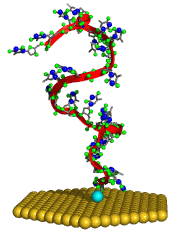What is a Biointerface?
The simplest biointerface is created when a biomolecule (e.g., DNA, RNA, protein, antibody) touches a solid surface. Complex biointerfaces can include larger biological objects like membranes, viruses, or cells that are brought into contact with inorganic, synthetic, or human-made materials.

The aim of biointerface science is to understand and control the behavior of such biological objects on surfaces. The complex nature of biointerfaces, places them at the figurative interface between sciences and often requires cooperation of many scientists to solve even the simplest problems. Physics, physical and analytical chemistry, and surface science provide the tools for studying biointerfaces. Surface chemistry is used to describe how molecules interact with surfaces. And the bio-components are described by different branches of biology, such as biochemistry, molecular biology, structural biology, or microbiology.
Why Study Biointerfaces?
If biomolecules and surfaces do not interface readily, why bother trying to force them into contact? A strong motivation comes from biotechnology and medical research. For example, many medical devices and materials could be vastly improved if their surfaces were modified to beneficially coexist with living organisms or tissues. The corresponding goal of biointerface science is creating surfaces that are biocompatible, rather than simply non-toxic (as are most current "biocompatible" materials).